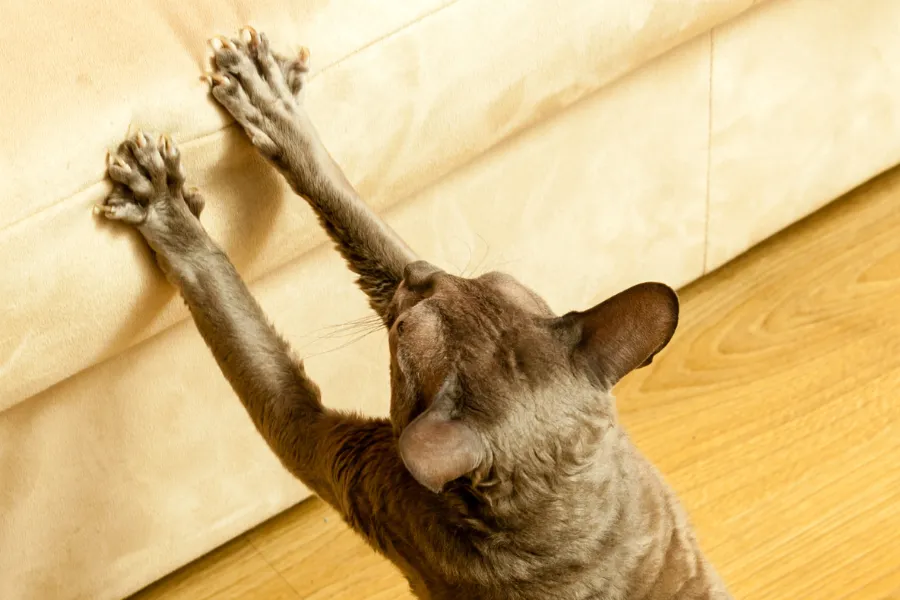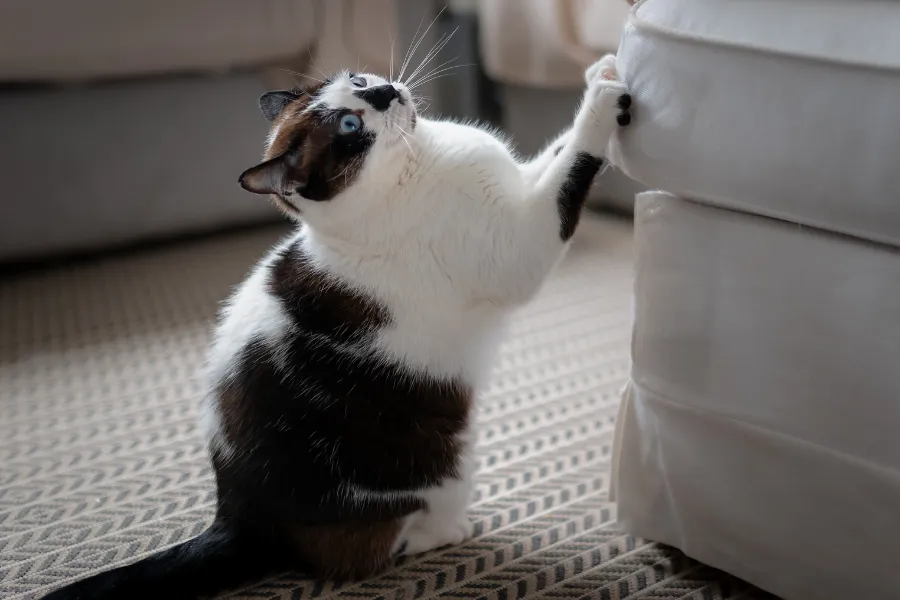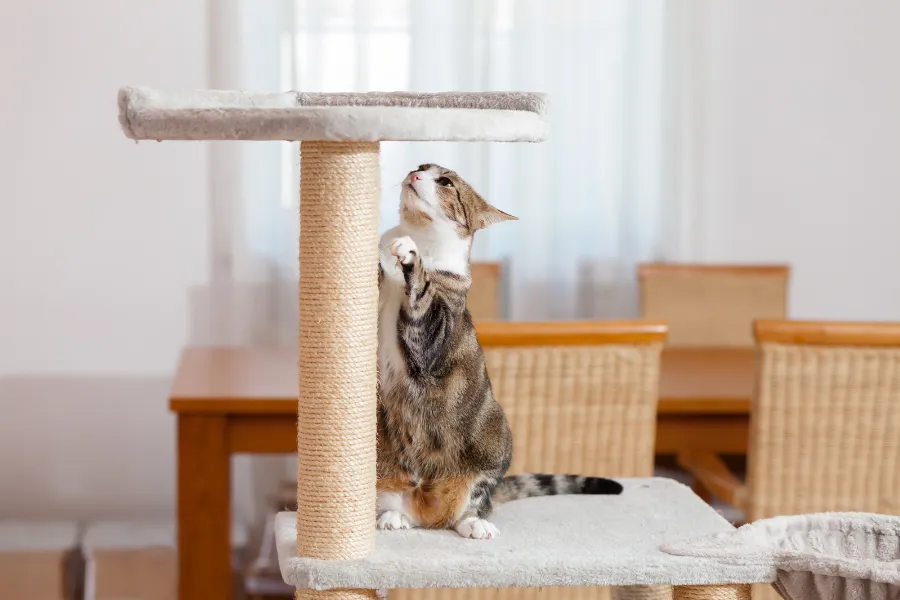Everyone loves cuddling up on their leather couch with a purring cat, but no one likes when their furniture gets scratched! You don’t have to give up on owning a cat or get rid of your leather couch – instead, explore these five methods for keeping cats from scratching the leather couch.
Do Cats Like Scratching Leather?
Cats need to scratch for various reasons, including territorial marking and stress relief. Unfortunately, our beloved furniture often bears the brunt of their scratching activities. But do cats like scratching leather?
It’s natural for cats to want to scratch. The texture and softness of the leather are incredibly enticing to them, so when given a chance, nearly all cats will happily sink their claws into a leather couch. While cats’ affinity for leather is understandable, it can also be problematic if you own expensive furniture or don’t understand why your cat needs to scratch your furniture in the first place.
There is no easy answer to this question, as every cat has preferences and personalities regarding scratching items in its environment. Some cats are more likely than others to develop an urge or habit of scratching leather due to a variety of factors such as age, sex, breed traits, individual personality traits, and even environmental influences such as media content seen or heard by the cat on TV or radio discourse such as animal noises, etc.
Scratching is a natural behavior for cats – research indicates that 79 percent of domestic house cats will routinely scratch objects within their living space.
However, some cats lack self-control which can put expensive leather couches in danger from unsolicited claws! So how can owners protect the integrity of their sofas without upsetting the feline equivalent member of the household?
Understanding why cats are inclined towards leather is vital in solving this dilemma – offering suitable alternative surfaces such as sisal rope posts, carpeted scratching pads, and horizontal scratcher mats.
Dotted around your living area should provide more accommodating options that keep your cat happy while protecting your furniture!

Why Do Cats Scratch Leather Furniture?
Cats are naturally inclined to scratch, as it helps to keep their claws in shape, clean off old nail sheaths, mark their territory, and even relieve stress. When cats scratch furniture like leather couches, it can be a cause of frustration and annoyance for pet owners. Understanding why cats do this is the first step toward finding an effective solution.
For starters, most cats tend to gravitate toward certain materials when scratching – leather couches often look particularly appealing with their smooth surfaces and sleek shapes.
By scratching them, cats can strengthen the muscles around their claws while leaving a territorial scent or mark that no one else can touch or remove. Additionally, they may find it easier to get friction from leather when compared to other materials like wood or fabric.
Sometimes cats may also use scratching to show dominance over humans in the household, especially if they feel someone has infringed upon “their” space (the couch). Alternatively, some cats enjoy the sensation of tearing through leather with their claws – just as some people enjoy playing air hockey for fun!
Boredom may be another reason cats scratch furniture – since there might not be enough stimulating activities in the house. In this case, pet owners should provide more interactive games, such as fishing-pole toys or feather chasers, that keep them busy and away from the furniture.
Finally, suppose no one is giving your cat attention or being deprived of affection or playtime with other animals during the day. In that case, they may instinctively search for ways to release pent-up energy through aggressive behaviors such as clawing objects in your home – including leather couches!
How to Stop Cats from Scratching a Leather Couch
Cats are curious, and it’s no surprise that they’re drawn to leather couches because of their texture. They may also use it as a scratching post. Unfortunately, leather isn’t the most durable for cats since its claws can easily rip or tear through it. To help keep your leather couch safe from your cats’ claws, here are five valuable methods you can try:
Provide Alternative Scratching Options
One of the best ways to prevent cats from scratching a leather couch is to provide alternative scratching options. This could be in the form of a scratching post. A cardboard scratcher placed near the item they’re trying to scratch or getting cat trees with different textural surfaces can invite cats to scratch these areas instead.
For some cats, the smell or feel of their nails may also trigger their instinct for scratching. Cats rely on scent and touch, so having something close by, such as a catnip toy, can distract them from wanting to scratch your furniture.
You can even add furry receptors, such as feathers or ribbons, around specific objects, encouraging your cat to replace destructive behaviors with more appropriate and attractive ones.
Cats use scratching posts and furniture as outlets for their pent-up energy, so if you have several cats in your home, it’s essential to keep their access to investigating and playing with various objects.
Providing multiple sleeping spots in different parts of the house allows cats to explore and stay active around other areas without stimulating the urge to continually mark their territory by relentlessly clawing at furniture in one particular area around your home.
Offering an abundance of perches near external doors also helps create new opportunities for exploration while keeping things interesting throughout different parts of the indoor environment too!

Use Furniture Protectors
Furniture protectors are one of the most effective ways to keep cats from scratching leather couches. These products come in various materials and styles, each designed to deter cats from sharpening their claws on furniture and other surfaces. There are several types of furniture protectors, including:
Vinyl strips
Vinyl strips can be placed around the edges of the couch and the arms, forming a barrier that makes it hard for cats to scratch.
Soft silicone mats
Mats made of soft silicone can be stuck onto the furniture surface, making it difficult for cats to get purchased and leaving a smooth surface difficult to scratch.
Furniture sprays
They are applied directly onto the couch or arm and feature a bitter taste that’s unpleasant for cats, discouraging them from returning.
These solutions should all last up to six weeks if applied correctly, though you may have to use additional coats in areas where your cat has been particularly persistent in his scratching attempts.
Additionally, some furniture protectors may work better depending on the type of material or fabric used for your couch. You can always consult with an expert or do your research online before deciding which one is best for you.
Use Scent as a Deterrent
Using scent as a deterrent is a popular method for keeping cats from scratching leather furniture. Cats rely heavily on the scent when they explore the world, and by making certain smells unpleasant, cats can be deterred from scratching your furniture.
One way to use scent as a deterrent is to find an essential oil that is not attractive to cats and spray it on the couch. Conversely, you could also use something like citrus-scented fake fur instead. You can also try adding citrus peels or using aromatherapy diffusers with scents of lavender or orange as deterrents.
Remember that this should only be used if you are okay with a strong scent in your space, as the intense odors might bother people too.
Another tip is to place objects with discernible textures around the area of your leather couch that might interest your cat more than scratching the leather, like old sheets of paper or carpet pieces.
Make sure you give your cats plenty of toys that mimic their natural habits, like lizards or mice, which they can scratch and claw without damaging any furniture – these might make suitable substitutes for leather couches!
Additionally, regular brushing and hairballs help cats maintain their claws without having them sharpen them all day long on fabrics, so it’s important to groom and brush your kitty often!
Create a Vinegar Deterrent
A vinegar deterrent can be an effective way to help keep cats from scratching leather furniture. Though it may seem strange, cats are naturally repelled by the smell of vinegar. To create a vinegar deterrent, add half a cup of white vinegar to one quart of water and mix in ten drops of citrus essential oil—the citrus oil’s aroma masks the vinegar’s smell.
Once mixed, pour it into a spray bottle and mist it around your leather couch or furniture to keep cats away from that area. You can spray once or twice daily as needed and reapply after cleaning with a damp cloth.
Alternatively, apply cotton balls soaked in this solution directly onto your furniture. Some cats may still detect any residue left after vacuuming and wiping your table. With continuous application, your leather couch should remain cat-proof!
Use Special Cat Scratch Tape
Special tape designed to keep cats from scratching furniture is a straightforward solution for cat owners looking to protect their upholstery and leather furniture. This type of tape has a strong smell and sticky adhesive that cats find unappealing.
When they come into contact with it, they must quickly learn the material is off-limits. Cat scratch tape can be easily laid over leather couches, upholstered chairs, and other fabric surfaces subject to scratching to create a barrier between your cat’s claws and your belongings.
The best cat scratch tape is made from a thick adhesive that won’t peel off easily. It should also have an incredibly effective scent—like lemon or citronella—that cats are susceptible to, but humans may not even notice.
Before applying this product, ensure the furnished surface is clean, so there will be no debris that could interfere with its adhesive power or make it easier for cats to claw away at it. Most products come in rolls, so cutting them into small pieces makes them more manageable and easier to tamper against fabric surfaces without too much pressure.
Just be aware that some cats may become accustomed to the smell or texture of the particular tape over time, at which point you might have to switch out your brand for another, more practical option.

Trim Your Cat’s Nails Regularly
An excellent way to keep your cat’s nails from damaging your leather couch is to trim them regularly. This helps ensure that the nails don’t have a chance to get too long and prevents them from getting caught in any material on the couch. You may find that some cats are comfortable with you trimming their nails yourself. Still, others may require a trip to see the veterinarian for an assistant or even a professional groomer.
Regular nail maintenance is essential for cats of all ages because, unlike dogs, cats cannot wear their claws down naturally on surfaces like carpets or dirt. Allowing their nail length to become too long could lead to uncomfortable and painful problems, including breaking or snagging of the claws, which can cause infections and leave them vulnerable to disease.
While it can feel like an intimidating process, with patience and practice, you can care for your cat’s nails in healthy and safe ways for both of you! Try conditioning your cat over time by gently handling its paws as part of their regular playtime activities and putting treats afterward as rewards when they cooperate. This will help make your grooming sessions easier when it is time to trim those pesky claws!
Conclusion
In conclusion, cats scratching leather couch can be mitigated with a multi-step approach. Provide a scratching post in an area your cat likes to scratch. Using bitter apple on the couch’s surface, double-sided sticky tape to make the area around the sofa unpleasant for cats, and covering leather furniture with sheets or throws can all help to discourage cats from ruining your furniture.
Finally, providing enrichment activities that keep your cat busy and distracted may also help reduce scratching on the couch.
Owners should use both physical deterrents and distraction techniques because pet-proofing alone may not always be enough. When it comes down to it, cats are clever creatures who need guidance from their caretakers to learn which surfaces should not be scratched – after all, they’re only doing what comes naturally!
If you find yourself at wit’s end trying to keep your cat away from the leather couch, don’t get frustrated; remember, there are multiple strategies available that, when used together, can help keep your furniture in one piece.
